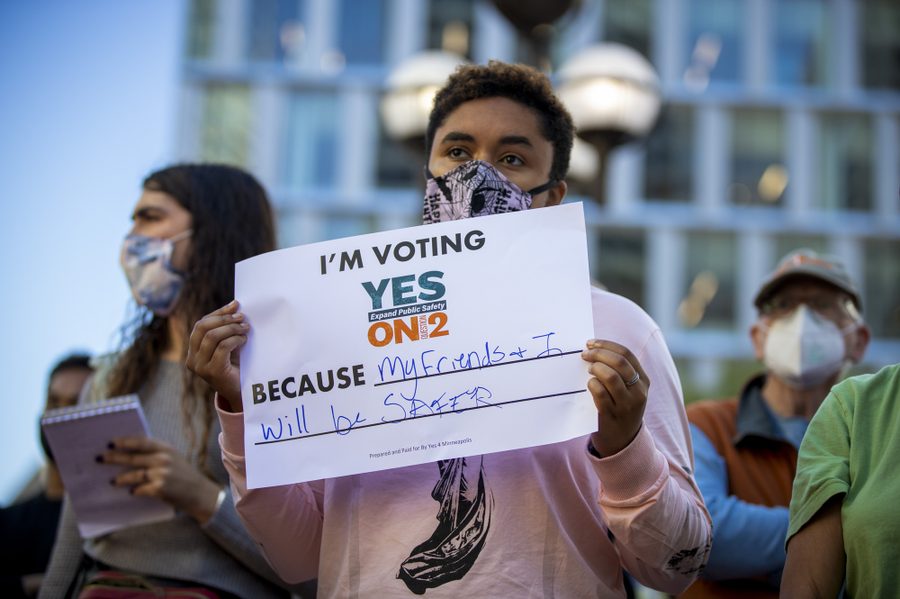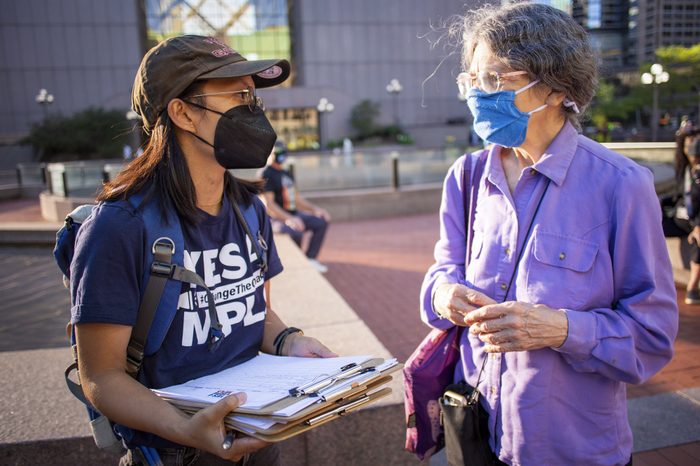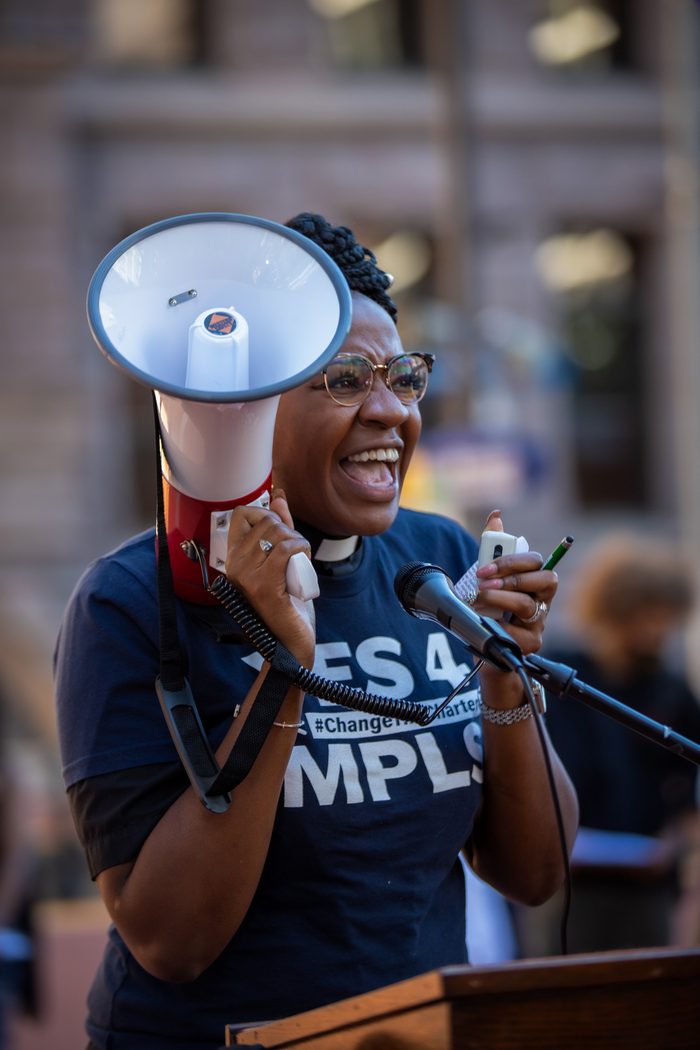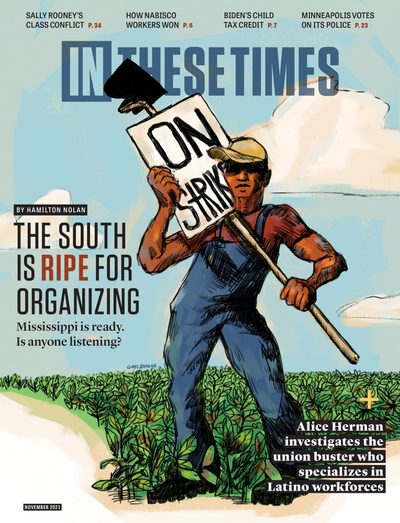Minneapolis Is About to Vote on Whether to Dismantle the Police
Will the city at the center of last summer’s racial justice protests decide to remake public safety? We’ll soon find out.
Logan Carroll

It was a cool Friday in Minneapolis, made cooler by the shadows of the skyscrapers towering over People’s Plaza. In the brick-lined courtyard between the Hennepin County Government Center and Minneapolis City Hall on September 17, the Yes 4 Minneapolis campaign and its allies held a rally whose purpose had come undone the day before.
Yes 4 Minneapolis is working to amend the Minneapolis City Charter by removing a mandate for a mayor-controlled police department with a certain number of officers per resident (0.0017, to be exact). In its place, the amendment establishes a Department of Public Safety under the joint control of the mayor and the 13-member Minneapolis City Council.
The radical restructuring would allow for future revisions. The new department could be led by a civilian and could easily redirect funds from armed officers to alternative responders, such as social workers. It would also be subject to more democratic control: the City Council represents a more diverse constituency than the mayor, who is primarily elected by wealthier, whiter parts of the city.
For the better part of a year, the campaign has been scrambling to respond to a slew of cheap shots from the opposition, a loose coalition of liberal politicians, the police chief and nonprofit and business leaders. The most recent curveball was a last-minute lawsuit that alleged the amendment question, which will be on the ballot in November, should be thrown out because of so-called misleading language.
On September 14, a district judge ruled to disallow the ballot question. On September 15, Yes 4 Minneapolis converted a planned get-out-the-vote rally to a demand-the-vote rally, where they would take the fight “to the streets,” Yes 4 Minneapolis communications director JaNaé Bates said. On September 16, the Minnesota Supreme Court overturned the earlier ruling. By September 17, the rally was back to its original purpose and had lost the momentum that could have carried people “to the streets.”
A shifting purpose wasn’t the rally’s only problem. The event was held at People’s Plaza to take advantage of the stately, copper-roofed Minneapolis City Hall as the backdrop. Periodically, however, trains blasted past, which would have drowned out the speakers had they not already been drowned out by the plaza’s fountains. According to Bates, the police had nixed the generator needed to power a sound system. Instead, speakers used a cheap microphone that barely carried sound unless it was held against their lips.
The rally felt like a distillation of the campaign’s general problems — complication after complication, wrapped up with much confusion. The opposition, meanwhile, has kept the campaign off-balance.
One poll shows 49% support for the amendment to 41% opposed it. A month before the election, doorknockers suggest the split is even tighter.
Dirty tricks
The Black Lives Matter movement began as a social media hashtag in 2013 in the wake of George Zimmerman’s acquittal in the extra-judicial killing of Trayvon Martin. Committed activists grew the campaign into a nationwide Movement for Black Lives network grounded in an argument for police abolition.
Policing in the United States, abolitionists argue, is built on the institution of slavery and the genocide of Native Americans. These atrocities are the foundation of policing. Its architecture is heavily influenced by Jim Crow.
Meanwhile, the scope of policing continues to expand. For example, in the past four decades, police budgets have ballooned while mental healthcare budgets have shrunk — and police have had to absorb the mission of mental health practitioners. Police abolitionists argue that policing cannot competently do everything demanded of it and cannot be reformed away from its core mission of using racialized violence to protect “the interests of the wealthy,” as one Minneapolis abolitionist organization, MPD150, writes.
Instead, the Movement for Black Lives calls for reimagining public safety, with mental health experts, school counselors, trauma-informed interventionists and restorative justice programs taking the place of the police, as well as funds for education, jobs, clean air, a universal basic income and other supports for communities historically stripped of resources.
In the Twin Cities, Black Visions Collective has been doing that long-term abolitionist work. The group shut down a key transit line in 2018 during Super Bowl LII in a protest for Black lives, and in 2019, with allied group Reclaim the Block, got $242,000 shifted out of the $193 million police budget to fund the Office of Violence Prevention.
Then, on May 25, 2020, Minneapolis police officer Derek Chauvin murdered George Floyd. The city became the epicenter of a fiery global protest movement, which also became (by some counts) the largest in U.S. history.
“We never thought 2020 would happen the way it did,” says Kandace Montgomery, Black Visions co-executive director. “Changing the [city] charter was something that we had predicted for a few years down the road, like 2023. But the opportunity presented itself.”
Black Visions and Reclaim the Block moved quickly to pressure the city council for action. Two weeks after Floyd’s murder, a veto-proof majority of nine councilmembers publicly pledged to defund and dismantle the police department. Minneapolis seemed poised to become a test case of abolition.
By December 2020, the council had been all but thwarted.
An initiative by the council to dismantle the police department was blocked from the November 2020 ballot by the Charter Commission, a judicially appointed board. The council pivoted to cut the department’s budget — but a group of Minneapolis residents swarmed the budget hearings in opposition in late 2020. Two councilmembers who had pledged to defund then voted to maintain the police staffing level, effectively thwarting the budget cut.
Later, it would be revealed that the leader of the “grassroots” pro-police effort, Bill Rodriguez, was actually a public relations consultant from the suburbs who had lied repeatedly about living in Minneapolis. Rodriguez was supported by an economic development consultant named Eric Won, who holds a mayoral appointment on a city budget advisory committee. Together, according to emails obtained from the city, the two men offered to use Won’s influence to support business development in Councilmember Alondra Cano’s ward shortly before she voted to keep police staffing at its current level.
The same tranche of emails shows Won and Rodriguez also coordinated with Minneapolis Mayor Jacob Frey, Police Chief Medaria Arradondo and a group of well-connected business and conservative community leaders, politicos and nonprofits.
This work grew into the coalition opposing the amendment change, composed of several interest groups.
The business and corporate interests were primarily represented by the Minneapolis Downtown Council, which sees the police department as necessary to keep downtown profitable. Real estate developers represent another significant part of the coalition, joined by the North Central States Regional Council of Carpenters.
Don and Sondra Samuels, leaders of anti-poverty nonprofits and two of the three plaintiffs in the lawsuit that temporarily threw out the ballot question, are the most visible of the centrist-leaning community and faith leaders. Members of this faction, mostly from North Minneapolis (a historically Black part of the city, due to a legacy of redlining), have been working for decades to incrementally reform the police department; they fear a sweeping reorganization of public safety could undo their efforts. They have a close relationship with Arradondo, a self-described “Northside baby” who also worked there as a beat officer.
The old guard of the Democratic-Farmer-Labor Party (the DFL is Minnesota’s Democratic Party, due to a fluke of history), mainly former city officials, represents another part of this coalition. They generally oppose comprehensive public safety reform in alignment with centrist Dems nationwide, including President Joe Biden, partly out of fear the GOP will use it as a wedge issue against them.
The last group, of course, is the police themselves. Arradondo has spoken out against the amendment, though the police union has remained quiet on the issue after becoming a flashpoint in the summer 2020 protests.
The mayor sits at the center. Frey signaled his broader political ambition in 2019 after a Twitter spat with former President Donald Trump. If re-elected in November, Frey will be mayor until 2025, leaving him free to run for governor or Congress in 2026. He may see this moment as an opportunity to build a constituency for a state or national run.
Of course, the factions are not clear-cut. Don Samuels is a former DFL city councilmember, and about half of the board of directors of Sondra Samuels’ nonprofit are corporate executives, consultants or lawyers.
“We did not go into this fight delusional,” says Yes 4 Minneapolis’s Bates. “[We knew] we were coming up against the Police Federation, big corporate lobbyists and corporate developers, as well as the current mayoral apparatus. They have been leveraging every bit of money and power against us.”
In short, Minneapolis has become a microcosm of the national opposition to the defund and abolish movement, with conservatives, wealthy interests and center-liberals driven by concern for neighbors, fear for property and an eye to their own political fortunes.
A slow start
The summer 2020 protest movement kindled a general openness to the question of defunding police (and the question of what investments can truly reduce crime), with some polls showing 41% support for shifting money from police departments into violence prevention initiatives. But as protests waned, the status quo reasserted itself. Trump and other Republican leaders used the movement to stoke fear, police unions threatened doom, Democratic mayors balked at budget cuts and the Democratic National Committee ran from “defund.”
In Minneapolis, after the Charter Commission blocked the first amendment attempt, activists decided to get the question on the ballot themselves. “[We] felt really clear that we needed to build a really robust coalition and a full campaign to get this thing on the ballot,” says Black Visions’ Kandace Montgomery. “And then get 50% plus 1 of the people in Minneapolis to vote for it.”
The plan sounded simple enough. What the amendment should actually say was more complicated.
Black Visions and Reclaim the Block sit on the radical end of a vibrant ecosystem of left-wing activism in the Twin Cities. Organizations range from TakeAction Minnesota, an advocacy group aligned with progressive Dems, to such openly socialist organizations as the base-building renters’ rights group Inquilinxs Unidxs por Justicia (United Renters for Justice). (Full disclosure: My wife, Jennifer Arnold, is executive director of Inquilinxs Unidxs, a member of Yes 4 Minneapolis.)
Black Visions had a strong roster of potential allies willing to talk police overhaul, but between fall 2020 and summer 2021, its coalition was slowed by a need to get “in alignment,” says Bates. The key divide was over the long-term vision of public safety: abolition or reform.
Montgomery argues for the abolition of policing — an institution grounded in racism — in favor of a completely different model of community investment. “When communities are well-resourced, they’re at their safest,” she says.
More reform-minded coalition members believe instead that police are necessary, but the notoriously violent Minneapolis Police Department needs to be replaced with something new.
The well-funded opposition, meanwhile, has built its campaign on spreading confusion about the amendment itself. For months, it has insisted the amendment would get rid of the police or the police chief. And Bates says those tactics worked.
“The lies and different disinformation initially did what it was created to do — to throw us off of our square and create confusion,” Bates says.
Legal battles further muddied the waters. The opposition has brought three related lawsuits to date. The first was against the city to demand it hire more police officers (as mandated by the City Charter). The judge ruled in its favor.
The second lawsuit targeted the original ballot question language, and the judge ruled in its favor, too. During Rosh Hashanah, the judge gave councilmembers (several of whom are Jewish) mere hours to revise the wording, lest it get tossed off the ballot.
The third lawsuit is the one that temporarily knocked the amendment off the ballot.

Yes 4 Minneapolis brought its own suit, too, challenging the wording of an explanatory note that would have accompanied the ballot question. The judge ruled in its favor, saying the note read like a “warning label.”
“We were trying to get in alignment while also facing absurd lawsuits, while also trying to land ballot language,” Bates says. “Some of your usual campaign activities had to be delayed.”
Yes 4 Minneapolis collected 20,000 signatures for a petition in April to secure the ballot question, then focused on internal organizing through August. Thanks in part to that work, Bates says the coalition reached an understanding: Reformers and abolitionists agree the status quo isn’t working.
Meanwhile, the opposition continues to promote disinformation, falsely claiming in glossy mailers that the amendment would “eliminate” the widely popular police chief, Arradondo, for example. Some of the attempts have backfired, however, such as a mailer that implied Minnesota Attorney General Keith Ellison opposed the amendment. In response, Ellison publicly announced his support.
Coming from behind
Yes 4 Minneapolis has done doorknocks, phone banks and information sessions, but much of their staff time has been spent just making sure core supporters understand the amendment, Bates says. They are only now starting to focus on the general electorate.
As of July 27, Yes 4 Minneapolis had more than $475,000, according to the most recent campaign finance filings. But it had spent just $6,200 on Facebook ads, compared to the opposition’s $47,000, as of September 27. (Neither side had paid for Google ads.)
“We’ll be on a lot of different platforms to engage different constituencies” in the coming weeks, Corenia Smith, campaign director for Yes 4 Minneapolis, told In These Times in mid-September.
Despite the slow start, Yes 4 Minneapolis has some advantages, first and foremost being its coalition members, including Black Visions, TakeAction Minnesota (which has spearheaded dozens of campaigns since 2006, from school tax levies to opposing voter ID laws) and Service Employees International Union (SEIU) Local 26 (with more than 8,000 members). Many of the groups are electoral campaign veterans and base-building organizations that have also engaged voters on the issue for months. TakeAction has been doing phone banking since March and doorknocking since the end of July, according to Katie Blanchard, TakeAction movement-building director. Black Visions has been doing doorknocks since the end of July, according to Montgomery. “Every coalition partner has been doing something in the field,” she says.
Yes 4 Minneapolis is finding it can flip some “no” voters simply by explaining what the amendment actually does. “It’s been really nice when we have conversations on the doors and we can correct [misinformation],” Smith says. “People just saying, like, ‘Oh, I totally thought it was this [other thing].’ ”
That point of distinction actually leads to another, potentially huge, advantage. In its hubris, the opposition chose for its main slogan, “a both/and approach” — as in, both reform and police — which is what the ballot question is actually about. So if Yes 4 Minneapolis can get its message out, the opposition has nowhere to pivot. Even Mayor Frey has announced his support for a Department of Public Safety, though he opposes using an amendment to create it.
In another recent development, Bates came on in July to co-lead the campaign with Smith. A former nurse, Smith had just a few months of organizing experience when she was hired in February — a deliberate move by the campaign to cut against “a history of not trusting community members, not trusting Black folks, not trusting women to lead and not supporting them,” Bates explains.
Bates adds five years of experience as communications director for Isaiah, a faith-based racial and economic justice group. The campaign is also bringing on veteran politico Javier Morillo, former president of SEIU Local 26, as a political advisor.
Light at the end of the tunnel
Twenty minutes into the rally on that cool day in September, things were already languishing. There were maybe 100 attendees, almost exclusively staff of member organizations, volunteers and press.
Bates took the final slot. She set aside the cheap microphone and held up a bullhorn, opening with a chant: “We are here. We won’t leave. We’ll have a city where we can breathe.”
She praised the rallygoers for their hard work. She recounted the campaign, blow by blow. She criticized what she called undemocratic attempts to prevent the vote. She encouraged people to do more volunteer work. And then she closed with another chant.

Her 10-minute speech was longer than it needed to be, but Bates understood the opportunity. Where other speakers addressed the press, perhaps hoping the journos would carry some nugget of narrative back to the electorate, Bates spoke to the people who had come.
The Yes 4 Minneapolis campaign has been off to a slow start for many reasons, and the final vote is anyone’s guess. A volunteer named Jesse Mortenson, who has done a dozen doorknocks and phone banks, thinks it’s going to be tight. “About a third of people are ready for change,” Mortenson says. “About a third feel that something is wrong, but aren’t sure this is the right thing to do.”
And the last third?
“Twenty percent of Minneapolis votes Republican, so that’s most of that number,” Mortenson says.
If Bates continues to take a more prominent role, if volunteers keep turning out, if experienced allies continue their support and if the opposition doesn’t find a new way to sink things — then the campaign might just scramble into a clear lead. That’s a lot of ifs, but the campaign is in a better position than it was at the beginning of summer.
Meanwhile, Minneapolis remains the closest city in the nation to reinventing public safety from the bottom up.
Logan Carroll is a freelance journalist in Minneapolis and focuses on city politics, online disinformation and the right wing. He co-hosts the podcast Unbalanced.mn.





